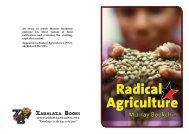smash-pacifism-zine
smash-pacifism-zine
smash-pacifism-zine
You also want an ePaper? Increase the reach of your titles
YUMPU automatically turns print PDFs into web optimized ePapers that Google loves.
pp. 47-48)<br />
In 1964, Williams helped establish the Deacons for<br />
Defense in Louisiana, a Black self-defence force with the<br />
purpose of protecting Black civil rights workers. The<br />
Deacons eventually had some 50 chapters across the<br />
Southern states. Williams also formed the Revolutionary<br />
Action Movement (RAM), an armed group advocating<br />
guerrilla warfare. He was later charged with kidnapping as<br />
a result of activities in Monroe, and fled to Cuba and then<br />
China. He also wrote Negroes with Guns in<br />
1962, which had some influence over the<br />
emerging debates on self-defence at the<br />
time.<br />
Another Black revolutionary<br />
organization Williams was involved in was<br />
the Republic of New Afrika (RNA), which<br />
sought the takeover of five southern states<br />
(Mississippi, Louisiana, Alabama, Georgia,<br />
and South Carolina). Williams resigned<br />
from the RNA when he returned to the US<br />
to fight the kidnapping charge.<br />
By 1963, amidst ongoing white<br />
racist violence against Blacks and civil<br />
rights workers, as well as the rupture of the<br />
Birmingham riots, the concept of armed<br />
self-defence became more widely<br />
promoted. Many 'nonviolent' organizers in<br />
the South armed themselves, adopting a<br />
measure already widely practised among<br />
Blacks in the region:<br />
“The advisability of self-defense—<br />
which in the Deep South meant, in effect, carrying guns—<br />
had long divided SNCC. Their experiences in Mississippi<br />
persuaded many staff members of the futility of attempting<br />
to dissuade local blacks from defending themselves against<br />
white aggression. SNCC had accepted the fact that many<br />
ordinary blacks possessed weapons and were prepared—<br />
quite rightly, in the view of some SNCC field workers—to<br />
use them in self-defense.<br />
“During a debate on nonviolence in June 1964, the<br />
executive committee agreed to stand by any SNCC worker<br />
'caught in the home of another person who is armed.' But it<br />
stopped short of approving the carrying of arms by SNCC<br />
workers themselves. By 1965, however, many staff<br />
members did possess guns.”<br />
(To Redeem the Soul of America, p. 313)<br />
“While the primarily northern urban riots were<br />
challenging the non-violent dominance of the black<br />
movement, the issue of self-defense was doing the same in<br />
the South. Violent attacks on civil rights workers may have<br />
bolstered the legitimacy of the cause, but this was little<br />
comfort to those whose lives were on the line. Although<br />
they did not make a public issue of it, almost every SNCC<br />
worker in the field was carrying a firearm by the time of the<br />
Malcolm X with M1 carbine;<br />
an advocate of armed defence.<br />
Mississippi Summer Project [1964].”<br />
(Black Radicals and the Civil Rights Mainstream,<br />
pp. 53-54)<br />
Similarly, CORE workers had also begun to arm<br />
themselves:<br />
“In 1965 a CORE worker in Ferriday, Louisiana,<br />
stated that self-defense in protection of one's home and<br />
person was 'taken for granted' and that most of the<br />
organization's headquarters in dangerous areas of Louisiana<br />
and Mississippi had weapons on the<br />
premises to protect against night attacks...<br />
Although the members were not of one<br />
mind on the subject, CORE was not strictly<br />
committed to nonviolence after 1965... and<br />
came very close to rescinding its official<br />
policy on nonviolence at the national<br />
convention that year.”<br />
(Black Radicals and the Civil Rights<br />
Mainstream, p. 54)<br />
Indeed, against the growing<br />
movement, white racists carried out a<br />
campaign of terror under the banner of the<br />
Ku Klux Klan or White Citizens Councils,<br />
including assaults, mob violence,<br />
bombings, and murders:<br />
“1965 saw an alarming rise in the<br />
number of civil rights-related murders:<br />
twenty people were killed that year,<br />
compared to fourteen in 1964 and thirteen<br />
in 1963. Eleven of the 1965 murders took<br />
place in Alabama and Mississippi, and no convictions had<br />
been obtained in any of these cases.”<br />
(To Redeem the Soul of America, p. 266)<br />
Faced with this widespread rejection of <strong>pacifism</strong><br />
and the reality of racist violence in the South, King himself<br />
had to concede that violent means were at times necessary.<br />
In a 1966 article he wrote entitled “Nonviolence: The Only<br />
Road to Freedom,” which he used to counter the popularity<br />
of the slogan Black Power and militant resistance, he<br />
conceded that:<br />
“There are many people who very honestly raise<br />
the question of self-defense. This must be placed in<br />
perspective. It goes without saying that people will protect<br />
their homes. This is a right guaranteed by the Constitution<br />
and respected even in the worst areas of the South.”<br />
(I Have A Dream, pp. 128-129)<br />
In an earlier article against Robert Williams' use of<br />
violence, King wrote “The Social Organization of<br />
Nonviolence,” in 1959. King identified three types of<br />
resistance: nonviolent, violent aggression, and violent selfdefence.<br />
Even at this time, he had to concede the necessity<br />
for defensive violence:<br />
64



